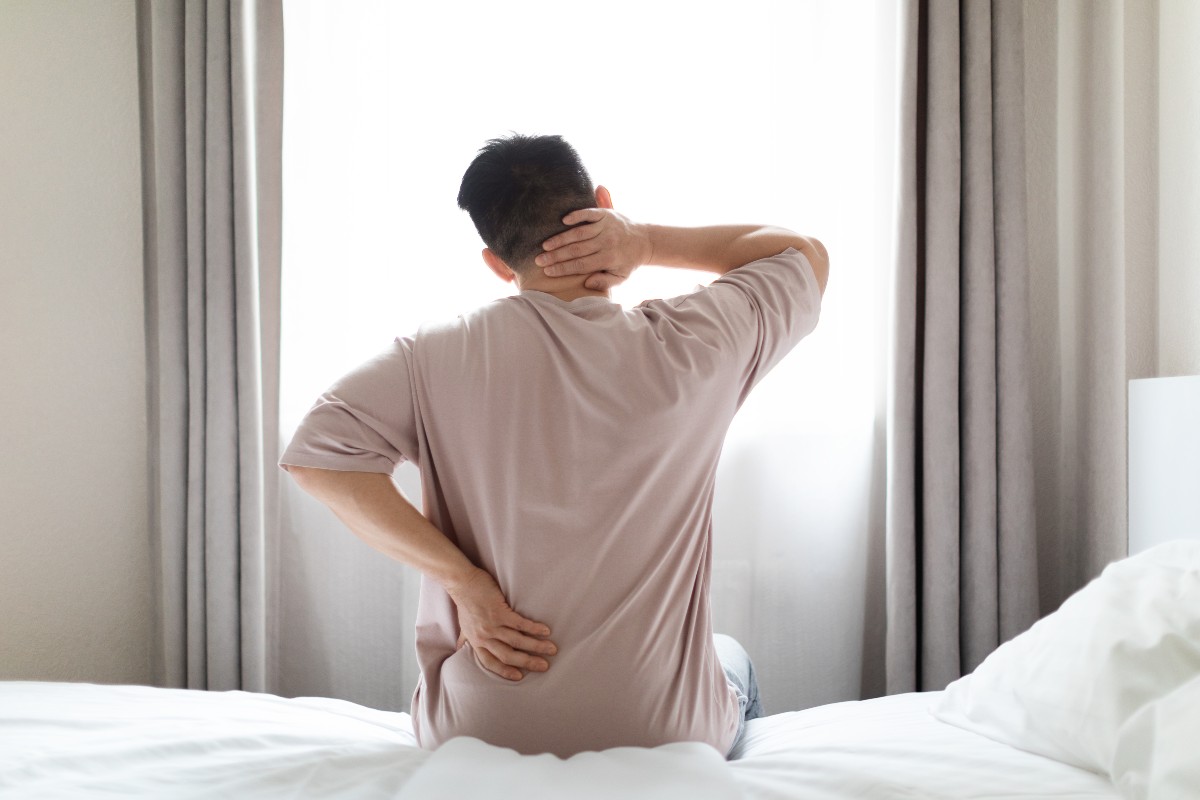
Is Your Sleep Becoming a Pain in the Neck?
We team up with an expert osteopath offering simple sleep tips for back and neck pain sufferers
Almost 3 million adults in the UK are regularly affected by chronic back pain (1) adults in the UK, and according to research from the British Chiropractic Association (2), more people are experiencing back or neck pain each week than they were five years ago.
There can be many reasons for this surge in pain sufferers, and some experts put this down to changes in our lifestyle, such as more people working from makeshift home desks plus a rise in the percentage of the population who are overweight or obese.
But what about when it comes to that most important activity, sleeping? What are the impacts of back and neck pain on our sleep patterns? And what can we do to learn how to sleep better with pain?
Well, this post explores how we can minimise our back and neck pain, and find positions that help us sleep better.
The relationship between sleep and back or neck pain
Back pain is often inextricably linked to sleeping. Whether it's difficulty nodding off because of the pain we feel, or the positions we sleep in causing us to wake up stiff and uncomfortable, our recent research has revealed that 43 per cent of Brits report that their mattress causes them more discomfort than it does relief. In addition, 56% report that they regularly have lower back pain, and 36% report neck pain.
To lend a helping hand to those suffering with pain when they sleep, we’ve joined forces with Mr Michael Fatica, Lead Osteopath and Co-founder of The Back In Shape Program, to raise awareness of some simple bedtime habits that can dramatically improve sleep quality for those living with chronic back or joint pain.
Back hygiene and how our sleeping positions can be the difference
Mr Fatica has helped thousands of people learn how to sleep with and manage back pain through his dedicated online rehabilitation program, and it’s all down to adopting better sleep positions as part of a "back hygiene" routine.
So, what are the sleeping positions that we should be avoiding, and which are the best positions to help with back pain?
Michael explains:
"The best sleeping position for back pain, by far, is on your side as it encourages a neutral spine. Use a pillow between your knees to maintain alignment and to reduce pressure on the hips and lower back. Aside from knee support, an extra pillow can also help align your neck or fill gaps in support around the body.”
The sleeping positions to avoid for pain
The fetal position
Lying on your side with your knees drawn up toward your chest is one of the most common sleep postures. Many of us associate it with warmth, comfort and emotional security.
However, when you curl too tightly, it can create too much rounding of the spine, particularly the lower back and neck. This unnatural curvature may overstretch spinal ligaments and muscles, leading to stiffness or making pre-existing pain even worse, especially when we wake up in the morning. Similarly, keeping the chin tucked down toward the chest can strain the cervical spine, contributing to neck pain and potentially causing tension headaches.
Unsupported side-lying
The key word here is ‘unsupported’, as lying on your side is generally considered one of the best sleep positions you can adopt. However, without proper support, it can contribute to spinal misalignment. This is especially prevalent in women, who generally have a wider pelvis, and can cause the top leg to rotate downward during sleep. This pulls on the lower spine and creates a twisting effect.
In turn, this posture can place undue pressure on the lower back and sciatic nerve. Over time, this may aggravate or even trigger symptoms of sciatica, including pain, numbness, or tingling that radiates from the lower back down the leg.
Fortunately, this is easily remedied by putting a pillow (or a specialist leg pillow) between your legs as you sleep.
Front sleeping
Sleeping on your stomach is one of the most debated positions among sleep and spine experts.
Those who love it point to the fact it can help reduce pressure on the lower back, especially when using a firm mattress that prevents the hips from sinking too deeply. For those who suffer from certain types of disc issues or degenerative conditions, this position might offer temporary relief.
However, the major drawback is what it does to the neck. Since breathing face-down isn’t practical (for example, if you want to be able to breathe), stomach sleepers must turn their head to one side for extended periods, which can create extreme rotation in the cervical spine. This unnatural twist can strain the neck muscles, compress nerves, and even lead to chronic pain or stiffness.
How to sleep with back or neck pain
If you’re looking for the best way to sleep with back or neck pain, it’s hard to go wrong with sleeping on your back, or on your side if you’re properly supported. Consider investing in U- or V-shaped pillows and cushions to help find the perfect position, and don’t forget that your choice of mattress is super important to feel comfy and supported.
If you don’t want to buy a whole new mattress, an orthopaedic mattress topper may also help.
Pre-bedtime back hygiene
Fatica also warns that the final hours before bed are crucial to a healthy back and reducing pain.
“For many of us, the last couple of hours leading up to bedtime are often spent sitting in front of the TV or other electronic devices, and often with poor posture. Gone are the days when advert breaks encouraged us to get up, for example, to make a hot drink and move around. We then go straight from sitting, which significantly compresses the discs in the vertebrae, to lying in bed for hours, and so naturally the back will suffer over such a long period of inactivity.”
Michael's Top 3 Tips for a Back-Healthy Bedtime:
- Move more before bed: Light stretching, such as hamstring or hip flexor stretches, can offset the strain from sitting.
- De-stress: Stress tightens muscles and aggravates back issues. A calming bedtime ritual — like reading, gentle music, or deep breathing — can support both mental and physical health.
- Alternate hot & cold: A warm bath stimulates circulation and eases muscle tension, while icing reduces inflammation. Combining both can aid tissue recovery and prepare the body for rest.
Our mattresses that can help with back & neck pain
As our Brand Marketing Manager, Rachel Marshall, highlights:
“We all sleep so differently and there's no 'one size fits all' when it comes to mattresses, which is why an in-store consultation to find the best one for you is highly recommended. With your perfect mattress combined with our tips from Michael, we hope that everyone can seek out a healthy and restorative sleep, free from pain."
To help find the perfect mattress to help you sleep better with back or neck pain, we’ve compiled a list below:
- Ortho by Slumberland: Our new Ortho mattress range features an exclusively designed Apex Max Pro™ Pocket Spring System which is proven to add a 20% increase in support vs a standard pocket sprung unit, offering a personalised feel and a responsive level of support usually only achieved with a mattress costing much more than the Ortho’s £799.99 starting price for a double.
- Sealy Posturepedic mattress: This mattress features spring technology which senses your shape and has edge support for added stability. An indulgent Latex layer adapts perfectly to your body for resilient, pressure relieving support, and there’s also a layer of premium InfiniLux™ foam for a luxurious feel.
- Simply Orthopaedic pocket spring mattress: You get 600 pocket springs which adapt individually to body movement, for superior responsive support. The mattress is constructed with some clever orthopaedic firm layers designed to offer support and promote spinal alignment for a comfortable night’s sleep, every night.
The modern world can make sleeping hard enough as it is, and that’s without factoring back or neck pain into the equation. If you’re living with back or neck pain, making small adjustments to your sleeping habits and investing in the right bed and mattress can make all the difference to how you feel in the morning.
To explore more expert advice, sleep tips, and guidance on choosing the right sleep setup for you, visit our Sleep Hub today. Alternatively, prioritise your rest, protect your back, and give your body the support it deserves with a new bed or mattress from Bensons for Beds.
Sources

Gemma Henry - Content Lead
Gemma finds sleep fascinating and describes the discovery aspect of her role as eye-opening. Her keen eye for detail and dedication to thorough research ensures that Bensons customers get the informative sleep-based advice they're looking for.